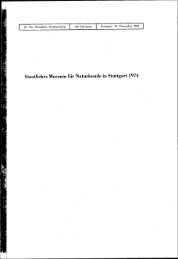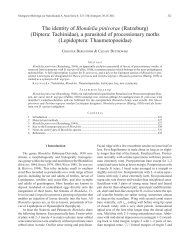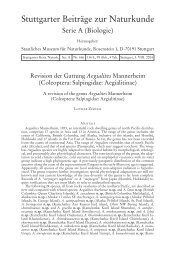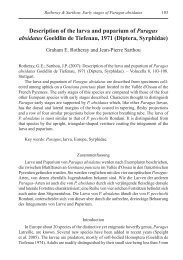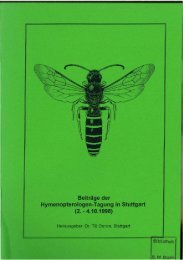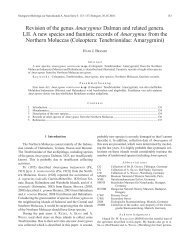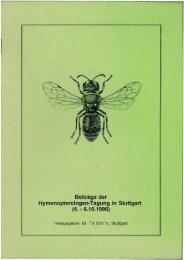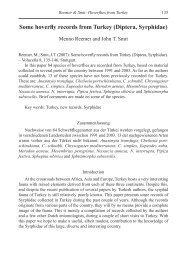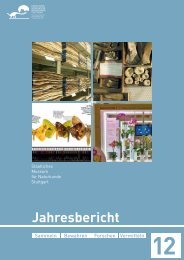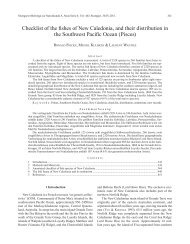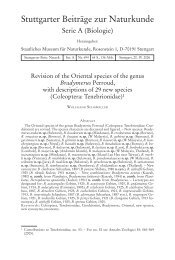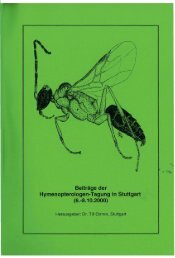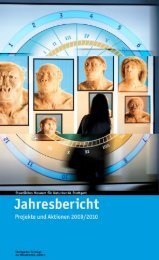The species of Bradymerus Perroud (Coleoptera: Tenebrionidae ...
The species of Bradymerus Perroud (Coleoptera: Tenebrionidae ...
The species of Bradymerus Perroud (Coleoptera: Tenebrionidae ...
Create successful ePaper yourself
Turn your PDF publications into a flip-book with our unique Google optimized e-Paper software.
SCHAWALLER, BRADYMERUS FROM NEW GUINEA AND THE MOLUCCAN ISLANDS 163tinct supraorbital furrows but without distinct supraorbitalkeels. Last 5 antennomeres forming a club. Anterior corners<strong>of</strong> pronotum distinctly protruding, lateral margin withfeeble crenulation, pronotal disc flat, with dense and partlyconfluent punctation, before base punctures more separate,between punctures without granules; pronotum before basewith shallow transverse impression. Elytra with puncturalrows without striae, punctures deeply impressed, intervals1–2 distinctly convex and with a row <strong>of</strong> feeble granules, intervals3–8 with complete and slightly sinuate keels. Tibiaeexternally without distinct keels; anterior male tibiae internallywith two narrow longitudinal stripes <strong>of</strong> densely setlight setae. Aedeagus see Fig. 54.Synonymy: B. keyensis Kulzer, 1951 is consideredas junior synonym <strong>of</strong> B. nigerrimus Gebien, 1922 becausethe reexamined type material <strong>of</strong> both taxa shows no distinctspecific differences. KULZER (1951) separated themmainly by the shape <strong>of</strong> the antennomeres, which cannot beverified by the present author.Distribution: New Guinea (type locality But <strong>of</strong> B.nigerrimus) including Waigeo Island, Key Islands (type locality<strong>of</strong> B. keyensis), Aru Islands.<strong>Bradymerus</strong> novaeguineense Kaszab, 1939(Fig. 12)Studied type material: Papua New Guinea, FriedrichWilhelmshafen, 1901, leg. L. BIRÓ, ♀ holotype HNHM.Diagnostic characters: Dorsal view seeFig. 12, dorsal side blackish without metallic shine, head,pronotum and elytra with short light setae, body length9.8 mm. Genae not broader than eyes, frons with distinctsupraorbital furrows but without distinct supraorbital keels.Last 5 antennomeres forming a club. Anterior corners <strong>of</strong>pronotum distinctly protruding, lateral margin with feeblecrenulation, pronotal disc convex, with dense but notconfluent punctation, between punctures without granules;pronotum before base with shallow transverse impression.Elytra with punctural rows without striae, punctures deeplyimpressed, all intervals distinctly convex and without granulesor keels. Tibiae externally without distinct keels; modifications<strong>of</strong> male tibiae unknown (only female available).Aedeagus unknown.Remarks: <strong>The</strong> generic assignment <strong>of</strong> this <strong>species</strong> isdoubtful, because its general habitus has a somewhat intermediateposition between <strong>Bradymerus</strong> and the relatedgenus Scotoderus <strong>Perroud</strong>, 1864. However, the pronotumis without deep basal furrow which is a main characteristic<strong>of</strong> Scotoderus (KASZAB 1973). Unfortunately, the holotypeis a female, and the aedeagi <strong>of</strong> the Scotoderus <strong>species</strong> areunknown, thus the aedeagi cannot be taken into considerationfor generic assignment.Distribution: New Guinea (type locality FriedrichWilhelmshafen, now Madang).<strong>Bradymerus</strong> papuanus (Kaszab, 1939) n. comb.(Figs. 21, 44)Planibates papuanus Kaszab, 1939.Examined material: West Papua, Testega, Meydoudga,1100–1350 m, 10.IV.1993, leg. A. RIEDEL, 3 ex. SMNS.– West Papua, Testega, 1100–1300 m, 30.III.–12.IV.1993, leg. A.RIEDEL, 4 ex. SMNS. – West Papua, 50 km S Nabire, Pusppenssat,750 m, 31.XII.1997, leg. A. WEIGEL, 1 ex. CRGT.Diagnostic characters: Dorsal view seeFig. 21, dorsal side blackish without metallic shine, bodylength 7.0–8.5 mm. Genae not broader than eyes, fronswith weak supraorbital furrows but without distinct supraorbitalkeels. Last 4 antennomeres forming a club. Anteriorcorners <strong>of</strong> pronotum distinctly protruding, lateralmargin with feeble crenulation, pronotal disc flat, withdense but not confluent punctation, disc medially withlongitudinal impunctate stripe, between punctures withoutgranules; pronotum before base with distinct transverseimpression. Elytra with punctural rows with striae, puncturesnormally impressed, internal intervals flat, externalintervals convex, intervals sometimes with traces <strong>of</strong> smallgranules. Tibiae externally without distinct keels; male anteriortibiae with distinct internal tooth before the middle.Aedeagus see Fig. 44.Synonymy: KASZAB (1939) described the genusPlanibates, based on the type <strong>species</strong> P. papuanus Kaszab,1939. <strong>The</strong> modified anterior tibia in males was regardedby him as the main diagnostic character for Planibates.However, this character is not generic and occurs also insome <strong>species</strong> <strong>of</strong> <strong>Bradymerus</strong> (SCHAWALLER 2006). All othercharacters coincide. Thus, Planibates Kaszab, 1939 is considereda junior synonym <strong>of</strong> <strong>Bradymerus</strong> <strong>Perroud</strong>, 1864.Planibates aeneus Kaszab, 1980 and P. fukiensis Kaszab,1954 were already transferred to <strong>Bradymerus</strong> by SCHA-WALLER (2006). Probably, also the genus Calabosca Fairmaire,1894 (type <strong>species</strong> pedinoides Fairmaire, 1893 fromIndochina) is synonymous with <strong>Bradymerus</strong>.Distribution: New Guinea (type locality Simbang).<strong>Bradymerus</strong> plicicollis (Fairmaire, 1896)(Figs. 8, 55)Osdara plicicollis Fairmaire, 1896.Examined material: Papua New Guinea (labelled asD. N. Guinea), Morobe Prov., Sattelberg, XII.1908, leg. R. NEU-HAUSS, 8 ex. MNB. – Papua New Guinea, Huon Golf, Sattelberg,



